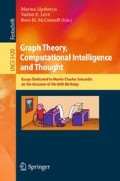Abstract
A unit cube in k dimensions (k-cube) is defined as the Cartesian product R 1×R 2× ⋯ ×R k where R i (for 1 ≤ i ≤ k) is a closed interval of the form [a i ,a i + 1] on the real line. A graph G on n nodes is said to be representable as the intersection of k-cubes (cube representation in k dimensions) if each vertex of G can be mapped to a k-cube such that two vertices are adjacent in G if and only if their corresponding k-cubes have a non-empty intersection. The cubicity of G denoted as cub(G) is the minimum k for which G can be represented as the intersection of k-cubes.
An interesting aspect about cubicity is that many problems known to be NP-complete for general graphs have polynomial time deterministic algorithms or have good approximation ratios in graphs of low cubicity. In most of these algorithms, computing a low dimensional cube representation of the given graph is usually the first step.
We give an O(bw·n) algorithm to compute the cube representation of a general graph G in bw + 1 dimensions given a bandwidth ordering of the vertices of G, where bw is the bandwidth of G. As a consequence, we get O(Δ) upper bounds on the cubicity of many well-known graph classes such as AT-free graphs, circular-arc graphs and cocomparability graphs which have O(Δ) bandwidth. Thus we have:
-
1
cub(G) ≤ 3Δ− 1, if G is an AT-free graph.
-
1
cub(G) ≤ 2Δ + 1, if G is a circular-arc graph.
-
1
cub(G) ≤ 2Δ, if G is a cocomparability graph.
Also for these graph classes, there are constant factor approximation algorithms for bandwidth computation that generate orderings of vertices with O(Δ) width. We can thus generate the cube representation of such graphs in O(Δ) dimensions in polynomial time.
The work done by the first and second authors was partially supported by a DST grant SR/S3/EECE/62/2006.
Access this chapter
Tax calculation will be finalised at checkout
Purchases are for personal use only
Preview
Unable to display preview. Download preview PDF.
References
Golumbic, M.C.: Algorithmic Graph Theory And Perfect Graphs. Academic Press, New York (1980)
Roberts, F.S.: On the boxicity and cubicity of a graph. In: Recent Progresses in Combinatorics, pp. 301–310. Academic Press, New York (1969)
Yannakakis, M.: The complexity of the partial order dimension problem. SIAM Journal on Algebraic Discrete Methods 3, 351–358 (1982)
Erlebach, T., Jansen, K., Seidel, E.: Polynomial-time approximation schemes for geometric intersection graphs. SIAM Journal on Computing 34(6), 1302–1323 (2005)
Afshani, P., Chan, T.: Approximation algorithms for maximum cliques in 3d unit-disk graphs. In: Proc. 17th Canadian Conference on Computational Geometry (CCCG), pp. 6–9 (2005)
van Leeuwen, E.J.: Approximation algorithms for unit disk graphs. In: Kratsch, D. (ed.) WG 2005. LNCS, vol. 3787, pp. 351–361. Springer, Heidelberg (2005)
Agarwal, P.K., van Kreveld, M., Suri, S.: Label placement by maximum independent set in rectangles. Comput. Geom. Theory Appl. 11, 209–218 (1998)
Berman, P., DasGupta, B., Muthukrishnan, S., Ramaswami, S.: Efficient approximation algorithms for tiling and packing problems with rectangles. J. Algorithms 41, 443–470 (2001)
Michael, T., Quint, T.: Sphere of influence graphs and the l ∞ -metric. Discrete Applied Mathematics 127, 447–460 (2003)
Fishburn, P.C.: On the sphericity and cubicity of graphs. Journal of Combinatorial Theory, Series B 35(3), 309–318 (1983)
Maehara, H.: Sphericity exceeds cubicity for almost all complete bipartite graphs. Journal of Combinatorial Theory, Series B 40(2), 231–235 (1986)
Michael, T., Quint, T.: Sphericity, cubicity, and edge clique covers of graphs. Discrete Applied Mathematics 154(8), 1309–1313 (2006)
Chandran, L.S., Mannino, C., Orialo, G.: On the cubicity of certain graphs. Information Processing Letters 94, 113–118 (2005)
Chandran, L.S., Francis, M.C., Sivadasan, N.: On the cubicity of interval graphs. Electronic Notes in Discrete Mathematics 29, 315–319 (2007)
Unger, W.: The complexity of the approximation of the bandwidth problem. In: Proceedings of the 39th IEEE Annual Symposium on Foundations of Computer Science, pp. 82–91 (November 1998)
Feige, U.: Approximating the bandwidth via volume respecting embeddings. In: Prceedings of the Thirtieth Annual ACM Symposium on Theory of Computing, pp. 90–99. ACM Press, New York (1998)
Turner, J.: On the probable performance of heuristics for bandwidth minimization. SIAM journal on computing 15, 561–580 (1986)
Kratsch, D., Stewart, L.: Approximating bandwidth by mixing layouts of interval graphs. SIAM Journal on Discrete Mathematics 15(4), 435–449 (2002)
Kloks, T., Kratsch, D., Borgne, Y.L., Müller, H.: Bandwidth of split and circular permutation graphs. In: Brandes, U., Wagner, D. (eds.) WG 2000. LNCS, vol. 1928, pp. 243–254. Springer, Heidelberg (2000)
Kloks, T., Kratsch, D., Müller, H.: Approximating the bandwidth of asteroidal triple-free graphs. Journal of algorithms 32(1), 41–57 (1999)
Kratsch, D., Stewart, L.: Domination on cocomparability graphs. SIAM Journal on Discrete Mathematics 6(3), 400–417 (1993)
Author information
Authors and Affiliations
Editor information
Editors and Affiliations
Rights and permissions
Copyright information
© 2009 Springer-Verlag Berlin Heidelberg
About this chapter
Cite this chapter
Chandran, L.S., Francis, M.C., Sivadasan, N. (2009). On the Cubicity of AT-Free Graphs and Circular-Arc Graphs. In: Lipshteyn, M., Levit, V.E., McConnell, R.M. (eds) Graph Theory, Computational Intelligence and Thought. Lecture Notes in Computer Science, vol 5420. Springer, Berlin, Heidelberg. https://doi.org/10.1007/978-3-642-02029-2_15
Download citation
DOI: https://doi.org/10.1007/978-3-642-02029-2_15
Publisher Name: Springer, Berlin, Heidelberg
Print ISBN: 978-3-642-02028-5
Online ISBN: 978-3-642-02029-2
eBook Packages: Computer ScienceComputer Science (R0)

